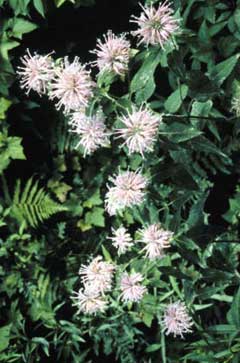
Wild Bergamot, Mintleaf bergamot, Wild Bee-Balm, Lupine
Latin Name: Monarda fistulosa
USDA Hardiness: 4-10
Native Range: NORTHERN AMERICA: Canada, Québec (southwest), Ontario (south), Saskatchewan (south), Alberta, Manitoba (south), British Columbia (south), United States, Connecticut, Indiana, Maine, Massachusetts, Michigan, New Hampshire, New Jersey, New York, Ohio, Pennsylvania, Rhode Island, Vermont, West Virginia, Illinois, Iowa, Kansas, Minnesota, Missouri, Nebraska, North Dakota, Oklahoma, South Dakota, Wisconsin, Colorado, Idaho, Montana, Wyoming, Alabama, Arkansas, Delaware, Georgia, Kentucky, Louisiana, Maryland, Mississippi, North Carolina, South Carolina, Tennessee, Virginia, New Mexico, Texas, Arizona, Utah, Mexico, Coahuila de Zaragoza,
Edibility Rating: 3 / 5
Medicinal Rating: 2 / 5
Region:
Family:
Plant Type:
Medicinal Uses
Edible Uses
Edible Parts: Flowers Leaves | Edible Uses: Condiment TeaLeaves - raw or cooked. The entire plant above ground level can be used as a potherb[183], though it is rather aromatic. It is also used as a flavouring in salads and cooked foods[46, 105, 183, 213]. The flowers make an attractive edible garnish in salads[183]. The fresh or dried leaves are brewed into a refreshing aromatic tea[183, 257].
Cultivation
Landscape Uses:Massing. Easily grown in ordinary garden soil so long as it is not too dry[1, 200]. Grows well in heavy clay soils. Requires a moist soil and a sunny position[1, 200], though it also succeeds in light shade[187]. This species thrives when grown in a dry soil[233, 238, K]. It prefers alkaline soil conditions[238]. Plants are hardy to at least -25°c[187]. A very ornamental plant, there are several named varieties[1, 233]. A good bee plant[200]. Subject to mildew in dry summers[200]. Special Features:Attracts birds, North American native, Attracts butterflies, Suitable for cut flowers, Attractive flowers or blooms. The plant is heat tolerant in zones 9 through 1. (Plant Hardiness Zones show how well plants withstand cold winter temperatures. Plant Heat Zones show when plants would start suffering from the heat. The Plant Heat Zone map is based on the number of "heat days" experienced in a given area where the temperature climbs to over 86 degrees F (30°C). At this temperature, many plants begin to suffer physiological damage. Heat Zones range from 1 (no heat days) to 12 (210 or more heat days). For example Heat Zone. 11-1 indicates that the plant is heat tolerant in zones 11 through 1.) For polyculture design as well as the above-ground architecture (form - tree, shrub etc. and size shown above) information on the habit and root pattern is also useful and given here if available. The plant growth habit is a runner spreading indefinitely by rhizomes or stolons [1-2]. The root pattern is rhizomatous with underground stems sending roots and shoots along their length [1-2].
Known Hazards
None known
Habitats
Dry thickets, clearings and woodland edges[43].